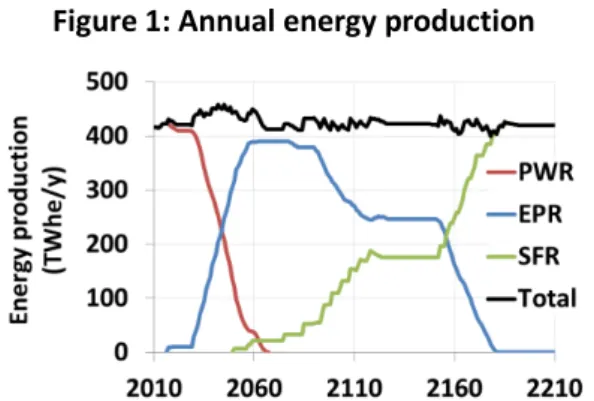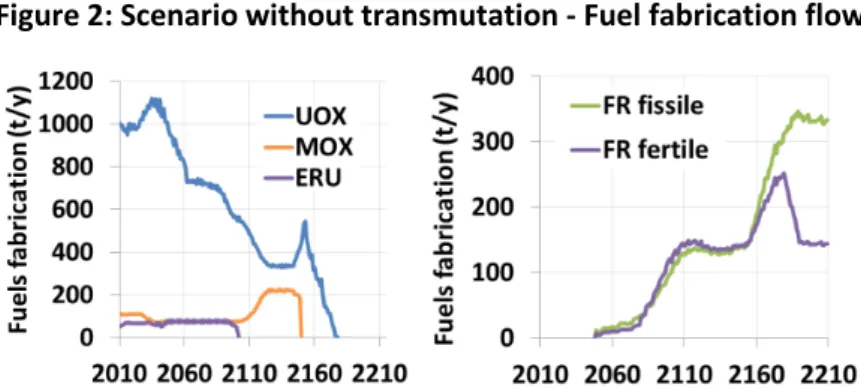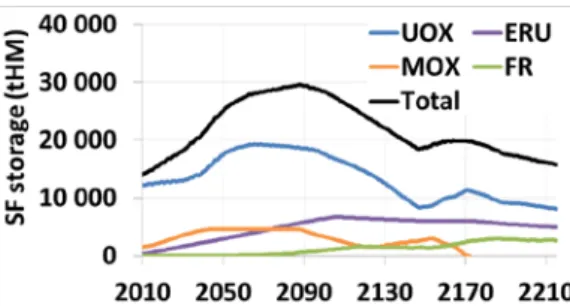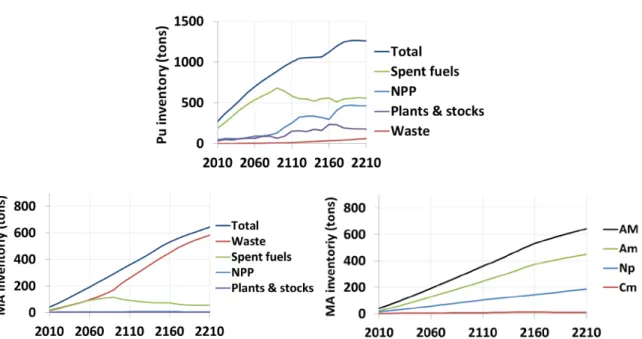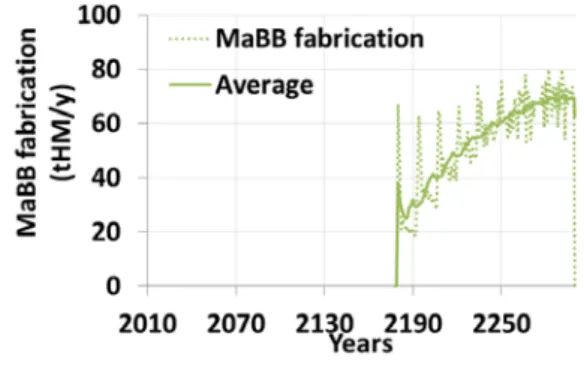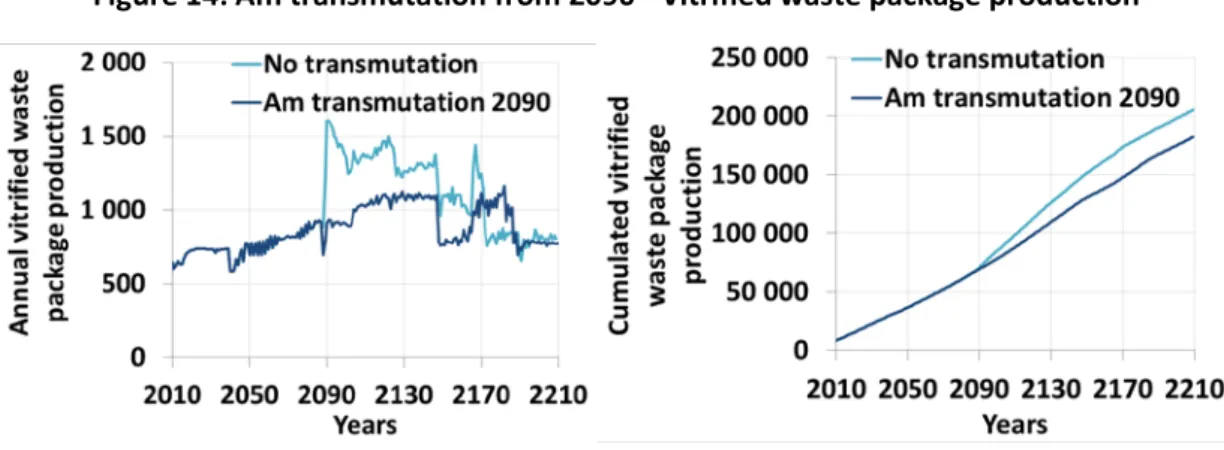HAL Id: cea-02438350
https://hal-cea.archives-ouvertes.fr/cea-02438350
Submitted on 14 Jan 2020HAL is a multi-disciplinary open access archive for the deposit and dissemination of sci-entific research documents, whether they are pub-lished or not. The documents may come from teaching and research institutions in France or abroad, or from public or private research centers.
L’archive ouverte pluridisciplinaire HAL, est destinée au dépôt et à la diffusion de documents scientifiques de niveau recherche, publiés ou non, émanant des établissements d’enseignement et de recherche français ou étrangers, des laboratoires publics ou privés.
Americium transmutation in a scenario of progressive
SFR deployment
M. Tiphine, C. Coquelet-Pascal, R. Eschbach, C. Chabert-Koralews, B.
Carlier, M. Caron-Charles, G. Senentz, F. Laugier
To cite this version:
M. Tiphine, C. Coquelet-Pascal, R. Eschbach, C. Chabert-Koralews, B. Carlier, et al.. Americium transmutation in a scenario of progressive SFR deployment. 14th Information Exchange Meeting on Actinide and Fission Product Partitioning and Transmutation (IEMPT - 2016), Oct 2016, San Diego, United States. �cea-02438350�
Americium transmutation in a scenario of progressive SFR deployment
Marion Tiphine*1, C. Coquelet-Pascal1, R. Eschbach1, C. Chabert1
B. Carlier2, M. Caron-Charles2, G. Senentz2
F. Laugier3
1CEA, DEN, Cadarache, DER, SPRC, F-13108 Saint-Paul-Lez-Durance, France 2AREVA, 3EDF DCN
Abstract
After the studies carried out in the frame of the 2006 French act for waste management, the CEA, EDF and AREVA decided to work together on potential progressive transition scenarios from the current French nuclear fleet to a SFR fleet which does not require natural uranium to operate. This paper describes one of these scenarios.
The first part of the paper focuses on the presentation and results of this transition scenario, with no minor actinides (MA) transmutation taken into account. The scenario starts with the current French fleet and its replacement by an EPR reactor fleet in which plutonium keeps on being monorecycled. MOX PWR spent fuel (SF) reprocessing begins in 2040 in order to feed three breakeven SFR, commissioned between 2050 and 2059. To prepare for a larger SFR deployment, three more SFRs are commissioned between 2075 and 2085 and small-scale SFR SF reprocessing starts in 2060. In 2090, additional SFR are deployed in order to stabilize total plutonium and used fuels inventories, with a fleet composed of 16 breeder SFR and 22 EPR reactors. Finally, between 2150 and 2185, this EPR/SFR reactor fleet is progressively renewed by a new one composed of 41 breakeven SFR. At the end of the scenario, the total Pu inventory is stabilized at 1260t (mostly present in SF and reactor cores) but the MA inventory in the waste is still increasing at a rate of 2.5tHM/y.
The following parts of the paper focus on the impact of americium (Am) transmutation in Am bearing blankets (AmBB) loaded in the SFR commissioned in the scenario. Two cases are described, one considering the Am transmutation in the fleet ultimately composed only of SFR, and the other one considering the Am transmutation starting with the mixed SFR/EPR fleet. Finally, one row of AmBB containing 10wt% of Am is enough to stabilize the Am inventory (in both cycle and waste) if the fleet is only composed only of SFR. In the case of a mixed fleet composed of 16 SFRs and 22 moxed EPRs, two rows of AmBB containing 15wt% of Am are required in each SFR core in order to recycle all of the separated Am. However, in that case the total Am inventory is not stabilized as it is still increasing in the spent fuel and blankets. It is noteworthy that, compared to a scenario with Pu multirecycling but without transmutation, Am transmutation in AmBB can lead to a 30% reduction of the radiotoxicity of the waste accumulated all over the scenario.
Introduction
Following the studies carried out in the frame of the French Act for waste management [1][2], the CEA, EDF and AREVA decided to work together on progressive potential scenarios of transition between the current French nuclear fleet and a SFR fleet which does not require natural uranium to operate.
Different scenarios considering the multirecycling of plutonium and the progressive deployment of a sodium fast reactor (SFR) fleet have been studied with the simulation software COSI developed by the CEA Nuclear Energy Division. Some of the results obtained on those scenarios are described in [3] and [4].
The potentiality of americium (Am) transmutation in americium bearing blankets (AmBB) has been evaluated for one of those scenarios. The results obtained for this scenario, with and without Am transmutation are discussed in this paper.
Scenarios assumptions
Calculation scheme
The scenario studies presented in this article have been performed with the COSI6 code developed by the CEA Nuclear Energy Division [5] [6]. COSI6 simulates the evolution of a pool of nuclear power plants and of its associated fuel cycle facilities over a define period (ranging from some years to some centuries). It gives access to fluxes and isotopic contents of materials at each point of the cycle and at any time of the scenario.
The evolution calculation is performed by coupling COSI with CESAR 5.3 [7], also developed by the CEA Nuclear Energy Division. CESAR 5.3 is the reference code used at the AREVA NC La Hague reprocessing plant to evaluate the isotopic content of spent fuels.
CESAR 5.3 computations are based on the JEFF 3.1.1 neutron data library and on cross sections libraries provided by the CEA reference depletion codes: APOLLO2 for thermal spectrum and ERANOS for fast spectrum.
Reactors and fuel cycle assumptions
The current French fleet is composed of 58 PWR, loaded with UOX fuels, ERU (Enriched Reprocessed Uranium) fuels and MOX fuels (a third of the fleet is loaded with 30% of MOX fuels). Those 58 PWR are commissioned between 1978 and 2002 and will be decommissioned until 2062. EPRs are commissioned at a rate of 2 EPR every 1.5 years up to 2051 and then 1 EPR every 1.5 years. The CFV V1 core concept [9], developed by the CEA, is the one considered for the SFR fleet. For the SFR cores, two power levels are considered: 1GWe and 1.45GWe. Both EPR and CFV cores characteristics are detailed in Table 1.
In the study described in this article, the americium transmutation is realized in americium bearing blankets (AmBB) loaded in the SFR cores. Those AmBB contain 10wt% or 15wt% and one or two rows of them can be loaded in SFR. Their characteristics are detailed in Table 2.
The SFR considered in the study can be used as breeder reactors by adding radial fertile blankets (FBR) around their cores. The FBR characteristics are also detailed in Table 2.
Table 1: Main neutronics characteristics of EPR and CFV cores
Units EPR CFV V1 CFV V1
Thermal power MWth 4500 3600 2400
Electrical Power MWe 1529 1450 1000
Net yield % 35.6 40.3 41.7
Load factor % 83 83 83
Fissile mass in core tHM* 120 52 36
Fertile axial mass in core tHM* - 34 21
Fertile radial mass in core tHM* - 22 14
Irradiation time EFPD* 3x460 5x388 5x388
Average fissile burn-up GWd/t 51.8 116 116
Equivalent 239Pu wt% - 15.5 15.5
*tHM: tons of Heavy Metal *EFPD: Equivalent Full Power Day
Table 2: Main characteristics of AmBB and FBR
Units AmBB 10% Row 1 AmBB 10% Row 2 AmBB 15% Row 1 AmBB 15% Row 2 FBR
Loaded mass tHM* 10.8 11.7 10.8 11.7 43.59
Irradiation cycles 5 5 5 5 1
Cycle length EFPD* 388 388 388 388 3880
Burn-up MWd/t 9740 2203 9249 1592 15967
*tHM: tons of Heavy Metal *EFPD: Equivalent Full Power Day
The fabrication time is fixed at 2 years for all type of fuel. The minimum cooling time before the reprocessing of spent fuel is 5 years, the effective cooling time being adapted to meet the need in fissile materials. All along the scenarios, the facilities capacities remain steady over several decades and are consistent with realistic values.
When SFR are loaded with AmBB, the AmBB are separated from the SFR fertile and fissile fuel at reprocessing. The storage of separated Am should remain below 15t.
The limits taken into account to evaluate the production of vitrified waste package are the following: – Mass of glass per package: 400kg;
– Maximal fission product and oxide content: 17.5%;
Description of the scenario
The scenario discussed in this article considers a progressive deployment of SFR in the French nuclear fleet in order to stabilize the Pu inventory and to stop relying on natural uranium extraction, while taking into account realistic constraints on the fuel cycle. To do so, several steps were defined:
– Step A: renewal of the current French fleet by an EPR one having the same characteristics;
– Step B: deployment of a few sodium fast reactors (SFR) and beginning of MOX spent fuel (SF) reprocessing to fuel the SFR fuel fabrication and stabilize the MOX SF storage;
– Step C: deployment of an EPR-SFR symbiotic fleet and beginning of SFR SF reprocessing to stabilize the Pu inventory;
– Step D: deployment of a 100% SFR fleet.
Figure 1: Annual energy production
All along the scenario, the energy production remains constant at 430TWhe (see Figure 1). The key dates of the “base-case” scenario, without Am transmutation, are the following:
– 2030-2060: renewal of the current French fleet by 35 European Pressurized Reactors (EPR) with an average 10% of MOX fuel in the fleet;
– 2040: beginning of MOX SF reprocessing;
– 2050-5059: deployment of 3 SFR of 1000MWe each;
– 2075-2085: deployment of 3 SFR of 1450MWe each and SFR spent fuel (SF) reprocessing on a small scale;
– 2090: SFR SF reprocessing on a large scale;
– 2094-2122: deployment of a mixed EPR-SFR fleet composed of 22 EPR (containing an average 39.5% of MOX fuel) and of 16 breeder SFR of 1450MWe each;
– 2153-2185: deployment of a 100% breakeven SFR fleet composed of 41 SFR of 1450MWe each.
The progressive deployment of SFR (3x1000MWe, and 3x1450MWe before commissioning a larger fleet) allows to take into account the industrial feedback on those reactors. The deployment of 3 CFV 1450MWe in 2075 and 2085 allows also to avoid a “gap” between the commissioning of the 1000MWe reactors in 2050-2059 and the deployment of the mixed EPR-FR fleet from 2094.
This scenario has been studied considering the Pu multirecycling without Am transmutation and with Am transmutation in AmBB from 2090 (when a significant number of SFR are available) and from 2180 (when only SFR are operating). The three cases are discussed in this article.
Main results on the scenario without Am transmutation Front-end Cycle
Due to the renewal of the PWR fleet by a SFR fleet and to the increase of the MOX fuel proportion in the PWR fleet, the PWR UOX fuel fabrication decreases all along the scenario while the PWR MOX fuel fabrication tends to increase (Figure 2). It reaches a maximum of 215tHM/y when the mixed PWR/SFR fleet is at its equilibrium.
The SFR fuel fabrication (Figure 2) follows the progressive deployment of the SFR fleet. The proportion of fissile and fertile fuels depends on the SFR breeding gain: breeder between 2090 and 2150 and breakeven from 2150.
Figure 2: Scenario without transmutation - Fuel fabrication flow
During the renewal of the current French fleet by EPRs, the increase in the MOX fuel burn-up leads to an increase in their Pu initial content (Figure 3). At step C, from 2100, the Pu providing the PWR MOX fuel fabrication comes from both UOX and SFR spent fuel reprocessing. This leads to some perturbation in the Pu content which remains near 11.4% up to 2120 and reaches its maximum (an average Pu content of 12wt%) between 2120 and 2130.
Up to 2100, while the Pu for FR fissile fuels fabrication comes from PWR MOX SF reprocessing, the Pu content in SFR fissile fresh fuel (Figure 3) is around 26%. It decreases as the proportion of SFR fuel at reprocessing increases and reaches 22% in 2200.
Back-end Cycle
Due to differences in the required Pu fissile content, spent fuel (SF) reprocessing to feed the PWR fuel (Figure 4) fabrication is separated from the reprocessing to feed the SFR fuel fabrication (Figure 4).
Figure 4: Scenario without transmutation - Reprocessing flows
Until 2100, the PWR MOX fuel fabrication is supplied with Pu from UOX SF. In 2090, when the PWR-SFR symbiotic fleet is being deployed, the multirecycling of Pu begins: the fissile content of Pu issued from MOX SF is enhanced in fast reactors before re-using it in PWR. Between 2120 and 2150, SFR SF represents 20% of the reprocessing flow to supply the PWR MOX fabrication. Note that the decrease in the reprocessing capacity in 2040 is linked to a more efficient use of Pu in EPR than in the current French fleet reactors.
SFR fissile fuel is first fabricated with Pu from PWR MOX SF. SFR SF is reprocessed according to its availability, beginning at a small scale (15 then 21 tHM/y) between 2060 and 2090 and increasing from 2090. At the end of the scenario, when the equilibrium of the SFR fleet is reached, 550tHM/y are reprocessed, 90% of which being SFR SF.
All along the scenario, UOX SF represents the major part of the SF storage (Figure 5). Due to a decrease in the UOX SF reprocessing in 2040, the UOX SF storage increases and reaches its maximum (19100tHM) between 2055 and 2095. Past this date, due to the UOX SF reprocessing and a decrease in the UOX fuel fabrication, it decreases and reaches 8200tHM at the end of the scenario.
Figure 5: Scenario without transmutation - Spent fuel storage
It is noteworthy that the different steps objectives of SF stabilization are fulfilled. The UOX SF storage is stabilized until 2090 (steps A and B) and the MOX SF storage is stabilized (at 4650tHM) between 2045 and 2090 (step B). At step D, due to breakeven cores, the SFR SF storage is stabilized at 2700tHM.
Pu and minor actinides Inventories
The Pu inventory (Figure 6) is mainly composed of the Pu in the stored spent fuel. It increases steadily until 2120, date on which it becomes stable for the first time (at 1055t), in accordance with the step C objective. During the 100% SFR fleet deployment, the Pu inventory increases again and finally becomes stable once again in 2180 (at 1260t). At the end of the scenario, in 2210, 17% of the Pu inventory is composed of separated Pu (stored between reprocessing and fabrication) and of Pu in spent fuel cooled enough to be reprocessed (cooling time > 5y).
As this scenario does not include any transmutation strategy, the minor actinides (MA) inventory (Figure 6) increases all along the scenario and reaches 645t in 2210. At this date, 91% of the MA are contained in the vitrified wastes.
Figure 6: Scenario without MA transmutation - Pu and MA inventories
Americium (Am) is the most present MA in the minor actinide inventory (Figure 6). In order to stabilize the Am inventory, transmutation studies have been carried out. Those studies are discussed in the rest of the article.
Scenarios including americium transmutation
Following the study of Pu multirecycling, the potentiality of americium (Am) transmutation has been evaluated. In these studies, the Am transmutation is realized by loading one or two rows of americium bearing blankets (AmBB) around the SFR cores.
Two scenarios are discussed here, the first one considering the beginning of Am transmutation in 2180, when the fleet is only composed of SFR, the second one considering the transmutation of Am from 2090, at the beginning of the mixed PWR/SFR fleet, when a substantial number of SFR is commissioned.
Am transmutation in the 100% SFR fleet
Until 2175, this scenario is identical to the one without Am transmutation. In 2180, a fleet composed of 41 breakeven SFR reaches its equilibrium. Five years before this date, in 2175, the Am separation at reprocessing begins. The fabrication of AmBB starts in 2178. From 2180, one row of AmBB containing 10wt% of americium is loaded in each SFR.
From 2175, SFR and PWR UOX spent fuels are reprocessed in order to have enough Pu for the SFR fissile fuel fabrication and in order to keep the separated Pu storage stabilized. The Am coming from the reprocessing of SFR and PWR UOX spent fuels is used for AmBB fabrication. When available, used AmBB are reprocessed only when more Am is required for AmBB fabrication. This choice was made in order to limit the amount of stored separated Am.
Front-end Cycle
Neither the needs in SFR fuel fabrication nor their initial Pu content is impacted by Am transmutation. However, the 238Pu content of SFR fissile fresh fuel increases by 0.01wt% per year from 2190, going from 0.8wt% at this date to 1.8wt% in 2290. Indeed, the Pu coming from spent AmBB reprocessing is used for SFR fissile fuel fabrication and the 238Pu content of this Pu can reach 30wt%.
By adding one row of AmBB in all the 41 SFR, the maximum annual AmBB fabrication would be of 69tHM/y. However, the AmBB fabrication being limited by the Am availability, the effective AmBB fabrication reaches this maximum of 69tHM/y after almost 100y of Am transmutation (Figure 7).
Figure 7: Am transmutation from 2180 - AmBB fabrication
Back-end Cycle
SFR SF flux at reprocessing is not impacted by Am transmutation and, in order to limit the amount of stored separated Pu, PWR UOX and ERU spent fuel reprocessing stops when AmBB reprocessing begins.
As explained previously, from 2175 Am coming from SFR and PWR UOX spent fuel reprocessing is separated and used for AmBB fabrication. When available, spent AmBB are reprocessed according to the need of additional Am. The first spent AmBB are available for reprocessing in 2190. At this date, 21tHM/y of AmBB are reprocessed. Following the AmBB fabrication and the spent AmBB availability, the AmBB reprocessing increases by 0.4tHM/y in average and reach 68tHM/y in 2290 (Figure 8).
The spent fuel (SF) storage is not significantly impacted by Am transmutation (Figure 8). In order to keep the separated Pu storage stabilized, and because of the Pu production in AmBB, the SFR SF reprocessing is slightly reduced so that the SFR SF storage keeps on increasing by 4tHM/y. In order to feed the AmBB fabrication, all the available spent AmBB are reprocessed so that the spent AmBB storage is composed only of irradiated AmBB cooled less than 5 years. In 2290, it becomes stable at around 350tHM.
Figure 8: Am transmutation from 2180 - Spent fuel reprocessing (left) and SF storage (right)
It is noteworthy that the storage of separated Am remains below 8 tons at the beginning of Am separation. From 2179, all the Am coming from SFR SF reprocessing being used for AmBB fabrication, and spent AmBB being reprocessed according to the need in Am, there is no more stored separated Am.
Inventories
Am transmutation in one row of AmBB containing 10wt% of Am is sufficient to stabilize the Am total inventory from 2210 (Figure 9). In the scenario without Am transmutation, from 2180 the Am inventory keeps on increasing at a rate of 1.3t/y so that, in 2290 the transmutation of Am in one row of AmBB 10% leads to a reduction of the Am inventory of 120t (-22%).
Figure 9: Am transmutation from 2180 - Am and Pu inventories
The minor actinides (MA) inventory keeps on increasing, but the transmutation of americium leads to a reduction of its increasing rate. Thus, from 2210, the MA inventory increases by 0.9t/y whereas in the scenario without transmutation the increase is of 2.1t/y.
However, the production of Pu in AmBB leads to an increase in the Pu inventory which is no longer stabilized (Figure 9). From 2210, the Pu inventory starts increasing by 2.1t/y.
Vitrified Waste Packages
The vitrified waste inventory is almost not impacted by the Am transmutation. Indeed, in 2175 and until the end of the scenario the vitrified waste package production is driven by the mass of fission product and actinide oxide whether Am is transmuted or not. The Am transmutation doesn’t have a significant impact on the quantity of oxide being sent to the waste and so, does not impact the annual vitrified waste package production.
Conclusions on Am transmutation from 2180
With a fleet composed only of breakeven SFR, loading one row of AmBB with an initial Am content of 10% in every SFR is sufficient to stabilize the Am total inventory.
However, unless considering the scenario on relatively long times, the transmutation of Am from 2180 does not lead to a significant reduction of the Am inventory or to a reduction of the vitrified waste package production. Indeed, in this scenario an important part of the americium is produced by the irradiation of PWR MOX fuel before that date. In 2180, the spent PWR MOX fuel has already been sent to the waste and the americium contained in it can no longer be transmuted.
For these reasons, the next study focuses on an early beginning of Am transmutation. Am transmutation from 2090
Starting the Am transmutation in 2090 allows to transmute the Am contained in PWR MOX SF but also to benefit from the SFR on a longer period of time.
In this scenario from 2088 the Am coming from the reprocessing of spent PWR and SFR fuel is used for AmBB fabrication. In order not to store a too important amount of separated Am, spent AmBB are reprocessed according to the need in additional Am for AmBB fabrication.
As the PWR MOX spent fuel contains important quantities of Am, a preliminary study has been carried out to evaluate the amount of AmBB required to use this separated Am and to maintain the storage of separated Am below 15t. Three cases have been studied:
– One row of AmBB containing 10% of Am (“AmBB 10%”); – Two rows of AmBB containing 10% of Am;
– Two rows of AmBB containing 15% of Am (“AmBB 15%”).
The conclusion of this preliminary study is that one row of AmBB 10% is not sufficient to use all the Am separated during the PWR MOX SF reprocessing: the storage of separated Am reaches a maximum of 83t. This maximum can be reduced at 23t if two rows of AmBB 10% are loaded in SFR, but two rows of AmBB 15% are necessary to maintain the separated Am storage below 15t (with a maximum of 13t in that case).
Following this preliminary study, two rows of AmBB 15% are loaded in the SFR cores between 2090 and 2180. Past this date, as the scenario of Am transmutation from 2180 showed the possibility to
stabilize the Am inventory with one row of AmBB 10%, the Am content is reduced at 10% and only one row of AmBB is loaded in SFR cores. The key dates of the scenario are the following:
– 2088: Am separation at reprocessing and beginning of AmBB 15% fabrication; – 2090: two rows of AmBB 15% are loaded in 1.45GWe SFR;
– 2178: beginning of AmBB 10% fabrication; – 2180: one row of AmBB 10% is loaded in SFR.
In the scenario without transmutation, some SFR are converted into breeder reactors by adding radial fertile blankets (FBR) around their cores. When required, the addition of AmBB to transmute americium is done at the expense of the FBR. Another preliminary study aimed at evaluating the impact of the replacement of FBR by AmBB on the Pu isotopy. The main conclusions of this study are that the 238Pu content in Pu from irradiated AmBB is greater that 30wt% whereas it is almost null in irradiated FBR. Similarly, the 242Pu content of Pu from AmBB reaches 7wt% whereas it is almost null in irradiated FBR. Those changes in the Pu isotopy lead to a decrease of 33% to 37% of the Pu fissile content. Consequently, in the mixed PWR/SFR fleet, Pu coming from the reprocessing of irradiated AmBB is used for the SFR fuel fabrication rather than for the PWR MOX fuel fabrication.
Front-end Cycle
The fabrication of AmBB (Figure 10) follows the deployment of the SFR fleets between 2088 and 2178. It reaches a maximum of 208tHM/y in 2177 and then decreases as the amount of AmBB loaded in SFR decreases from two to one row. In 2180 it becomes stable at 70tHM/y as every SFR is loaded with a row of AmBB.
For reasons explained previously, the Pu coming from the AmBB reprocessing is used for SFR fissile fuel fabrication. At step C, the loading of AmBB in SFR is done at the expense of the use of radial fertile blankets (FBR). Those FBR were used to increase the Pu fissile content in order to multirecycle it in PWR MOX fuel. Thus, the Am transmutation results in an increase of the fresh PWR MOX fuel average Pu content (Figure 10) which exceeds 12wt%.
Figure 10: Am transmutation from 2090 - AmBB fabrication (left) and PWR MOX Pu content (right)
The 238Pu content of fresh SFR fissile fuel is also greatly impacted, reaching a maximum of 4.2wt% in 2130 (to be compared to the 2.2wt% in the scenario without transmutation at the same date).
Back-end Cycle
Fluxes at reprocessing to feed both the PWR MOX and the SFR fissile fuel fabrication are impacted by the replacement of FBR by AmBB. To compensate for the replacement of FBR by AmBB, the PWR UOX SF reprocessing to feed the PWR MOX fuel fabrication is increased by 75tHM/y (+13%) from 2090 to 2150. Concerning the reprocessing to fuel the SFR fissile fuel fabrication, first the reprocessing of PWR MOX SF is increased by 26tHM/y (+18%) then, when all PWR MOX SF has been used, the reprocessing of PWR UOX SF is increased according to the need in Pu (Figure 11).
AmBB are reprocessed according to the need in Am (Figure 11): their reprocessing follows the AmBB fabrication, reaching a maximum of 114t/y in 2168 and decreasing when the number of rows loaded in SFR drops from two to one.
Figure 11: Am transmutation from 2090 - Rep. to fuel SFR fuel fab. (left) and AmBB rep. (right)
The increase of the PWR MOX and UOX spent fuel reprocessing leads to their resorption in spent fuel storages (Figure 12). The spent AmBB storage keeps on increasing at the end of the scenario because AmBB 15% are still reprocessed in 2210. It should get stable once all AmBB 15% have been reprocessed.
As explained in the description of this scenario, the choice of two rows of AmBB 15% at the beginning of Am separation allows to keep the separated storage below 15t (with a maximum of 13t reaches in 2095, Figure 12).
Inventories
Beginning the Am transmutation in 2090 allows to stabilize the Am inventory 60 years earlier than in the previous case (transmutation from 2180). In 2160, the Am inventory becomes stable at 320t (Figure 13). In 2210, the stabilized Am inventory is reduced by 125t (-28%) compared to the scenario without transmutation and by 110t (-26%) compared to the scenario of Am transmutation from 2180. Americium being the only minor actinides to be transmuted, the total MA inventory (Am, Np, Cm) is still increasing at the end of the scenario (+0.7t/y, to be compared to 0.9t/y if Am transmutation starts in 2180 and 2.1t/y without any transmutation).
As in the previous case, the Pu produced during the AmBB irradiation leads to an increase of the total Pu inventory. When equilibrium is reached, the total Pu inventory (Figure 13) steadily increases by 2.7t/y.
Figure 13: Am transmutation from 2090 - Am and Pu inventories
Vitrified Waste Packages
Am transmutation from 2090 leads also to a reduction of the vitrified waste package inventory (Figure 14). Indeed, in the scenario without Am transmutation, between 2088 and 2170 the reprocessing of PWR MOX spent fuel leads to an increase of the vitrified waste production due to the α emissions. Thus, between those dates, the separation of Am allows to reduce vitrified waste production by 26000 packages (-24%, Figure 14). As in the scenario of Am transmutation in 2180, when equilibrium is reached the vitrified waste production is rather the same whether Am is transmuted or not. When equilibrium is reached, the cumulated waste production is reduced by 23 270 packages which represents an 11% reduction in 2210.
Conclusion on Am transmutation from 2090
Beginning the transmutation of Am in 2090 allows to separate the americium when PWR MOX spent fuel is being reprocessed. In comparison with the scenario of Am transmutation from 2180, this leads to a much more efficient reduction of the Am inventory (-26% when equilibrium of the Am inventory is reached in both scenarios). It also leads to an important reduction of the vitrified waste packages production: - 23 270 packages when equilibrium is reached, which represents an 11% reduction in 2210 compared to both the scenario of Am transmutation from 2180 and the scenario without transmutation.
However, the Am transmutation in AmBB is not without consequences on the scenario results. In the scenario without transmutation, when the mixed PWR/SFR fleet is operating Pu is multirecycled in PWR MOX fuel thanks to an enhancement of its fissile content in SFR. As AmBB are loaded in SFR at the expense of radial fertile blankets, at the equilibrium of this mixed PWR/SFR fleet the average Pu content in PWR MOX fresh fuel is increased by 1wt%. At this moment, the average Pu content of PWR MOX fuel is above 12wt%.
It is also noteworthy that the Am transmutation is always done at the expense of the Pu inventory as the production of Pu during the AmBB irradiation leads to the loss of the Pu inventory stabilization. References
[1] C. Coquelet-Pascal et al. (2011), “Comparison of Different Scenarios for the Deployment of Fast Reactors in France - Results obtained with COSI”, Proc. of Global 2011, Makuhari, Japan.
[2] C. Coquelet-Pascal et al. (2013), “Scenarios for Fast Reactors Deployment with Plutonium Recycling”, Proc. of FR13, Paris, France.
[3] M. Tiphine et al. (2015), “Simulations of progressive potential scenarios of Pu multirecycling in SFR and associated phase-out in the French nuclear fleet”, Proc. of
Global 2015, Paris, France.
[4] G. Martin, M. Tiphine, C. Coquelet-Pascal (2016), “French transition scenarios toward a symbiotic nuclear fleet”, Proc. of ICAPP 2016, San Francisco, USA.
[5] C. Coquelet-Pascal et al. (2015), “COSI6: a tool for nuclear transition scenarios studies and application to SFR deployment scenarios with minor actinide transmutation”, Nucl.
Technol., 192.
[6] R. Eschbach et al. (2013), “New Developments and Prospects on COSI, the Simulation Software for Fuel Cycle Analysis”, Proc. of GLOBAL 2013, Salt Lake City, USA.
[7] J.M. Vidal et al. (2012), “CESAR5.3: an Industrial Tool for Nuclear Fuel and Waste Characterization with Associated Qualification”, Proc. of WM’12, Phoenix, USA.

